Table of Contents
Introduction
Many many years ago I played Battletech on the kitchen table. This was back in the 90s, shortly before the introduction of the clans, and gave me my first experiences with the system. I took a long break from it, but I’m starting to get back in. This was so long ago I remember the short lived cartoon, and I was definitely a 3025 era player.
I could talk for a long time about 80s wargame design, and to a large extent Battletech is unchanged from when I first played it (though the miniatures are much better). Modern audiences who didn’t grow up when tabletop wargaming was becoming popular don’t remember the growing pains when non-historical wargaming was working out whether it was an rpg combat system with miniatures or a wargame (see also Warhammer Fantasy Battle 1st edition, Rogue Trader, Laser Burn, Chainmail, Star Fleet Battles, etc). Needless to say a lot of these 80s games featured a character sheet mechanic, and Mech Record Sheets are a fixture of Battletech.
Mech record sheets provide you with the information you need to use that particular mech, and you get variations of the same mech chassis, which can be as simple as having a different gun, to as much as having different armour, weapons and systems. This leads to there being hundreds of mech record sheets out there and creating variants is a fan favourite activity with this sort of game design.
This means it is very common in Battletech (and seen in all of these products) to have a base model and a variant included for variety (so there is a Griffin N and a Griffin R in A Game of Armoured Combat, even though there is no Griffin miniature as they assume you’ll have one from the Beginner box). Variants, given they normally change the armament, can completely change the battlefield role. If a model goes from having all guns with a max range of 9 to being able to hit things 21 hexes away, then it makes a big difference to performance on the table.
I use some acronyms in this article, so SRM – Short Range Missile (a shorter ranged missile with a bigger warhead), LRM – Long Ranged Missile (longer range, less punch), AC is Autocannon, and the number is the amount of damage they do and PPC is Particle Projector Cannons, which is like a more damaging, hotter laser. You’ll see these throughout the Battletech articles, because who wants to write out Short Range Missile 15 times in an article.
Battletech has existed since the 1980s, and unlike Warhammer hasn’t had repeated new editions changing the rules, so there’s a colossal pile of confusing books and supplements for a player getting started. There are currently three different box sets commonly available, with a fourth coming later this fall. The fourth, Alpha Strike, adds to the confusion as its a different set of game rules that are cross-compatible with the same models.
We’re taking a look at the three current boxed products (the Beginner Box, A Game of Armored Combat, and Clan Invasion), what’s included in each, and which ones you need to play.
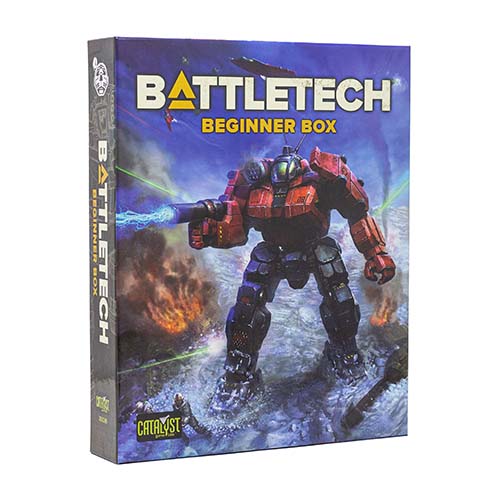
Beginner Box
The Beginner box retails fairly cheaply (cheaper than the smallest current 40k starter), and contains a starter rulebook, 2 mechs, a map, set of cardboard terrain counters and standees, a set of mech sheets and a short fiction book. The Beginner Box is a complete game experience, and with the standees included you can play a Lance vs Lance game. This game gives a simpler experience than classic Battletech, and I’ll go into why this is important for reasons other than the obvious in a bit.
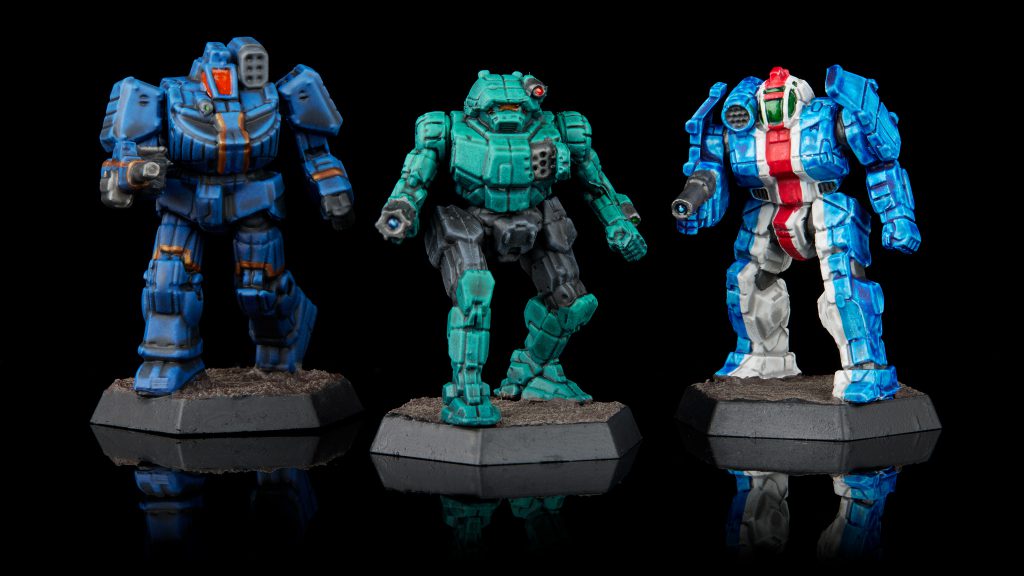
The Miniatures
The box contains two mechs, the Griffin and Wolverine. Both of these are solid 55 ton medium mechs, and a good addition to your collection, to the point where a lot of Battletech players pick up the beginner box for the miniatures. Starting in mid-to-late September 2022 the beginner box is being updated slightly to include a Vindicator rather than a Wolverine, with new box art to reflect the change. Outside of that change the rest of the content has stayed the same.
The updated box can be easily differentiated because it uses red instead of orange text on the cover, and is a slightly better purchase as if you continue on to the bigger A Game of Armored Combat box you’ll be picking up a Wolverine there, while there’s no other source for the Vindicator.

Griffin-1N – A solid trooper mech with an LRM-10 and PPC, making it a long range duellist. The Griffin wants to use mobility to stay far away from its opponent and pepper them with damage.

Wolverine-6R – More of a brawler with a Medium Laser, SRM-6 and AC/5, the Wolverine needs to get close to use all it’s weapon systems. This means it benefits from cover to prevent it taking a lot of damage on the way in.
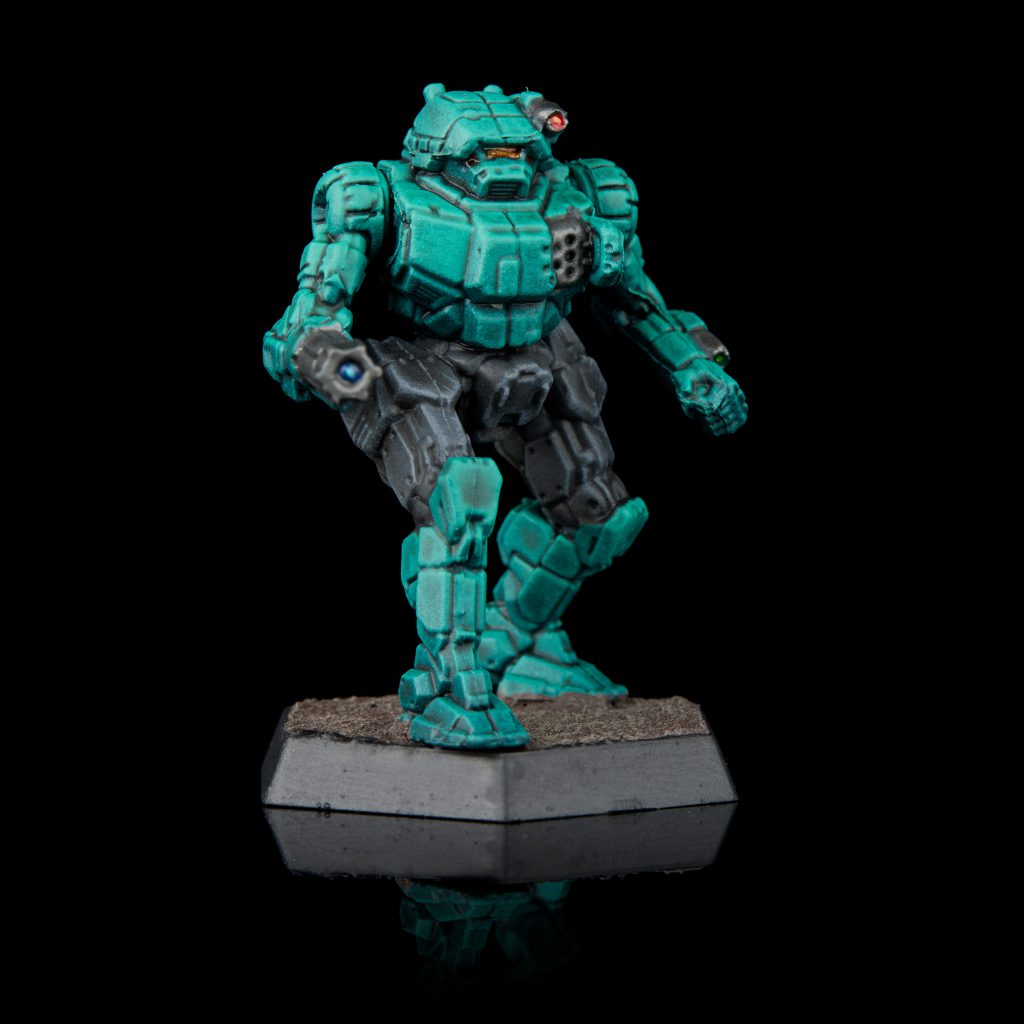
Vindicator-1R – A lighter mech than the Griffin, it carries a PPC, LRM-5, Medium Laser, and Small Laser. It has slightly less damage at range, but will do more up close, and has slightly less armor than the Griffin. To make up for it the pilot of the Vindicator is more skilled, so you’ll be landing more of those shots.
For some added variation as you play, the box includes a record sheet for an additional variant of each mech, including ones on the cardboard standees (a Locust and a Thunderbolt).
The Quick Start Rules
As you would expect, this is a heavily cut down set of rules, in the same way that playing 40k without the codices provides a stripped down experience. With a lot of the paperwork heavy rules not included, it lets you play through mech on mech action fairly quickly without worrying about heat or critical hits. You can still play a full on lance vs lance game using the cardboard standees in the box, and after playing a 1 vs 1 duel using the models, I recommend playing through the scenario with 2 vs 2 and then 4 vs 4. The mech choice is made for you, and the sides are reasonably balanced.
Importantly the core of the rules, movement, cover, GATOR (the process to work out what you need to roll to hit) and damage are all there making the transition to the full rules easier, as there is nothing to unlearn, just more detail to add in.
Conclusion
This box gives you a taste of the Battletech Classic experience. If you are thinking of getting into Battletech I would recommend this as a first purchase, as a) it’s cheap, b) it gives you a fairly complete experience in a single box and c) it gives you enough of a play experience that you can try the game out and find out if you like it. You aren’t burdened with force construction, the Quick Start rules gives you balanced forces for 1v1, 2v2 and 4v4.
If you are completely new to Battletech I highly recommend you start here. It gives you a taste of the system while retaining the flavour, and you can play a full 4vs4 game using it. 80s style game design is not for everyone, and this lets you try it before you heavily commit.
If you are happy with that, the next step is…..
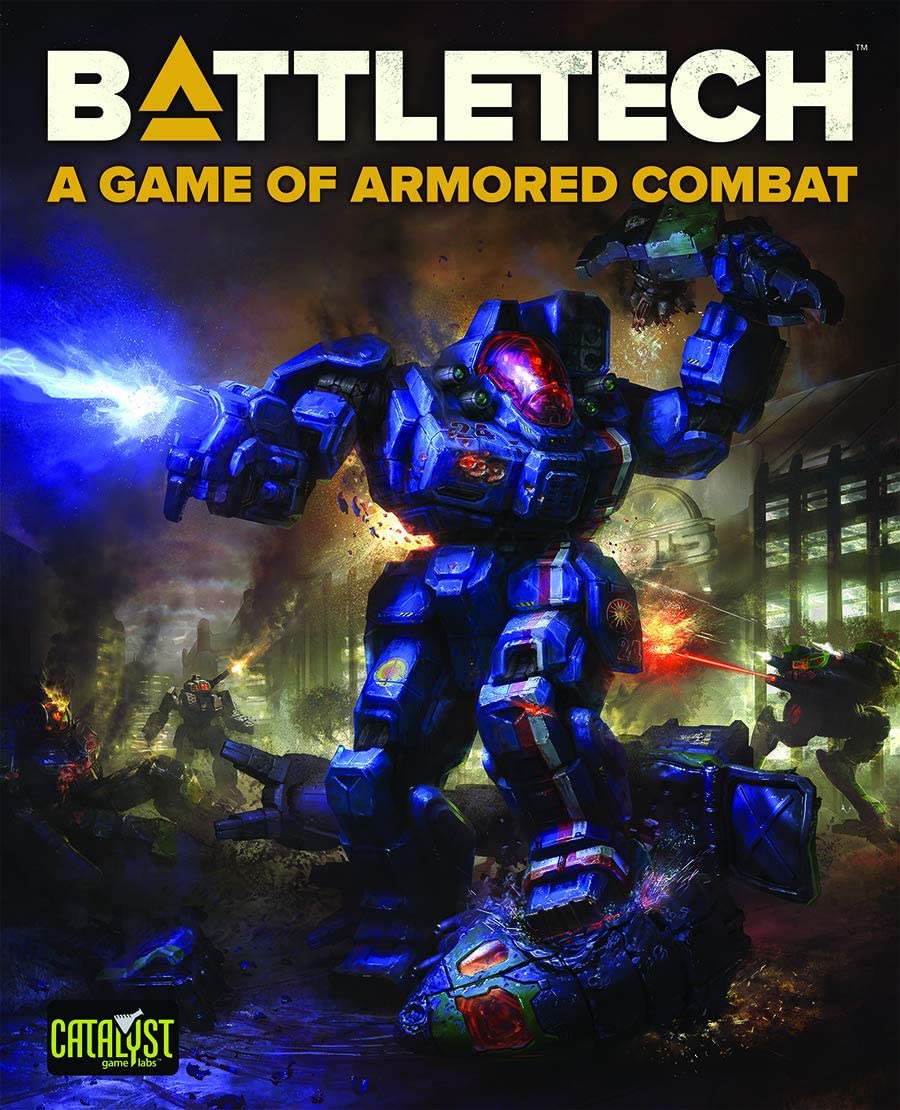
A Game of Armoured Combat
Battletech: A Game of Armoured Combat (AGoAC) is a true starter set, providing a bigger, fatter rulebook, 8 miniatures giving two complete Lances, and everything needed to play the game. You have full sized record sheets, points, the ‘full’ rules for mech combat, and even rules for designing your own mechs.
This is the latest iteration of the Battletech starter set that has been around in various editions for decades, with nice plastic miniatures. There was a previous starter set with plastic minis in the 25th Anniversary Intro box in 2011 (though with Wizkids you’ll notice the 25th Anniversary set was released in the 27th anniversary year), and the current miniatures are substantially better, showing the evolution of ‘boardgame’ miniatures in the eight years between sets.
While the rulebook is still slim compared to the full rulebook (Battletech: Total Warfare is the full rulebook, as there are a whole bunch of different rulebooks that can confuse a beginner) it covers mech on mech combat nicely, with close to the full rules. Certainly you have everything you need to play, with two lances of mechs, a map, the record sheets for mechs with variants for many of them, and rules complete enough to be a satisfying Battletech experience.

The Miniatures
You have the following miniatures, all of which are Battletech classics and worth having in your collection:
Light Mechs

Locust-1V – The Locust is a very fast, lightly armed scout mech. The default variant only has one medium laser and two machine guns, so will never be doing a ton of damage, but with its speed it can avoid a lot of fire and make sure its putting shots into the back of enemy mechs.
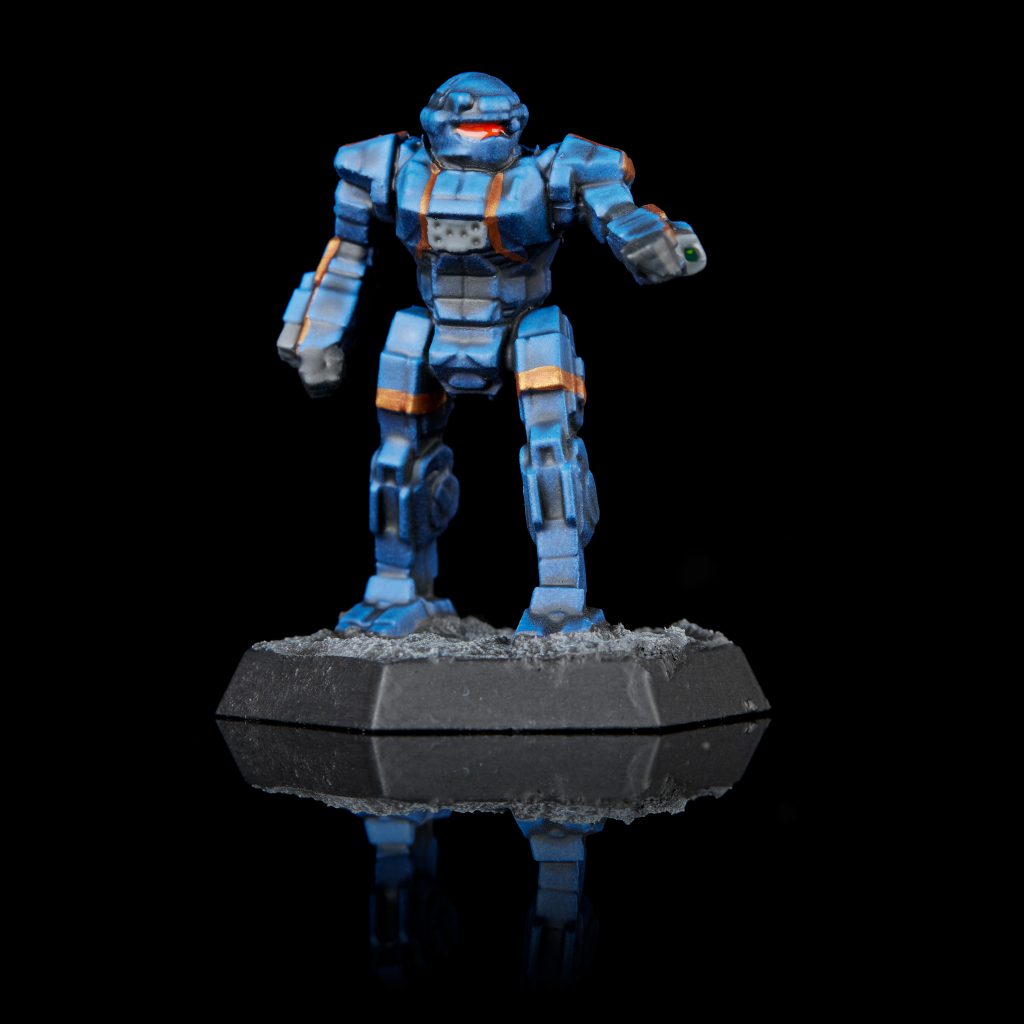
Commando-2D – The Command has an SRM-6, SRM-4 and Medium Laser, making it much more heavily armed than the Locust. Heavier than the Locust, the Commando has less armour and speed, both of which help keep light mechs alive.
Medium Mechs
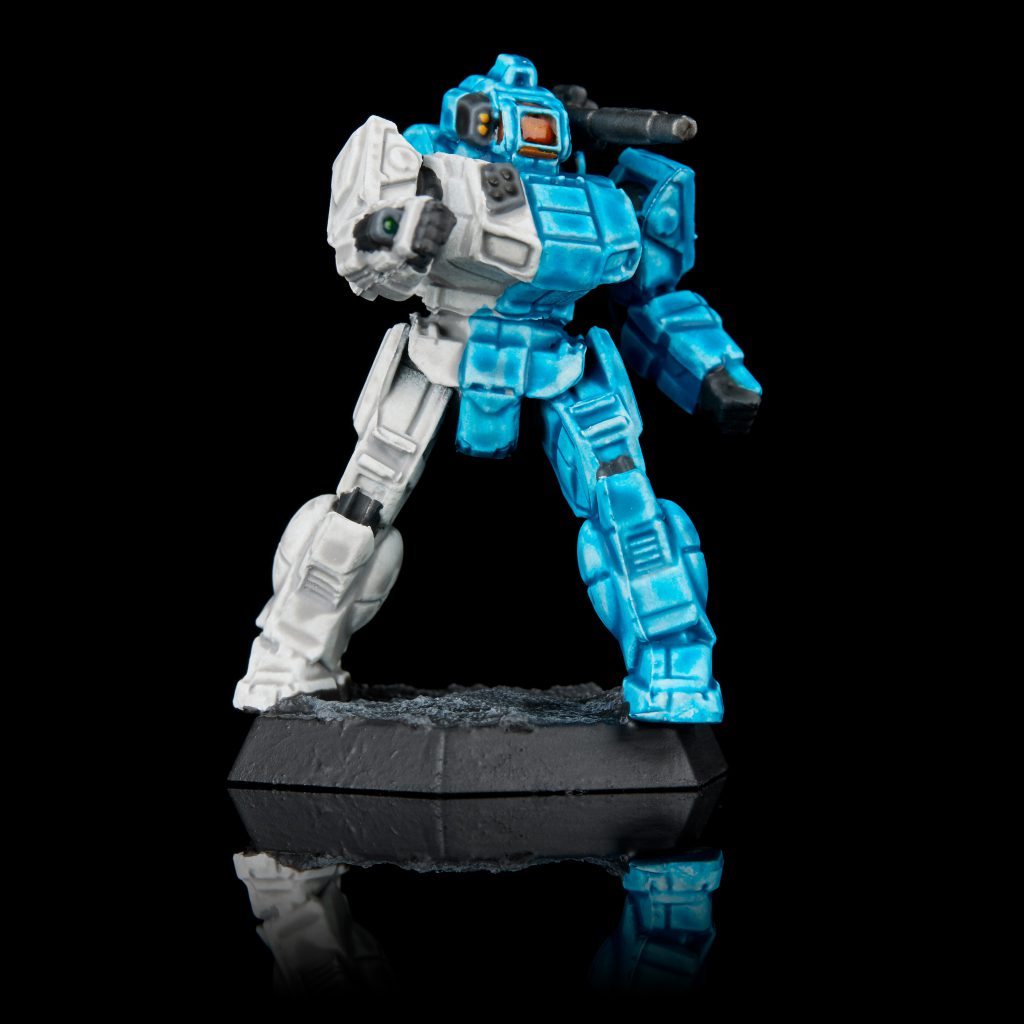
Shadow Hawk-2H – Another trooper mech like the Griffin in the beginner box, the Shadow Hawk has a real mix of weapons (SRM-2, LRM-5, AC/5 and Medium Laser) and can engage at long range with a reasonable punch, while having a bit extra when you get close. It can, however, become something of a jack-of-all-trades and master of none. About as well armoured as the Griffin (but with more on arms and centre torso and less on the legs and side torso) it’s an interesting mech and there are a huge number of variants for it.
Wolverine-6R – The same as the beginner box, the Wolverine functions in the same fashion but comes with the full game rules including heat and internal structure.
Heavy Mechs
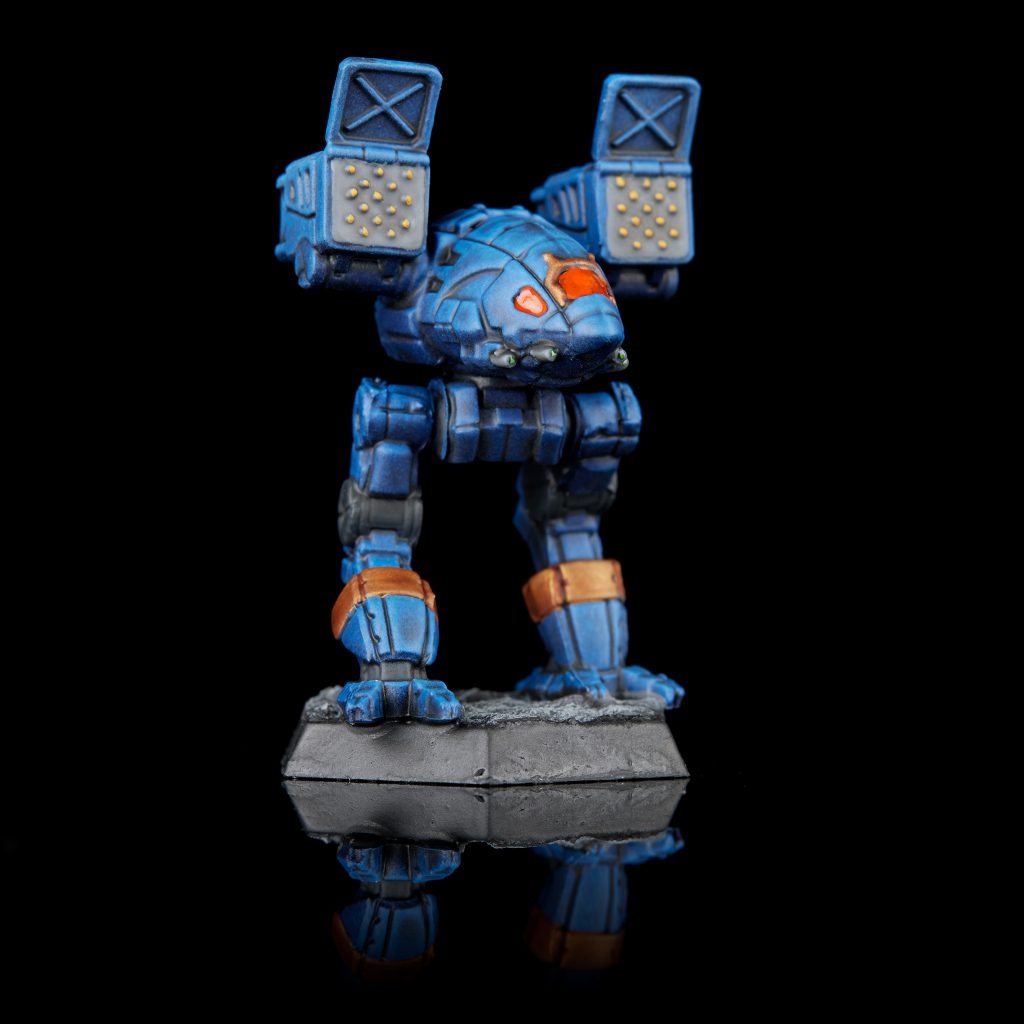
Catapult-C1 – The Catapult is a bombardment mech with two LRM-15s and four Medium Lasers for close in work, and best sat further back where it is harder for an opponent to get close or behind it. C1s pair well with another mech acting as spotter, and Locusts are great for that sort of task.

Thunderbolt-5S – A more straightforward brawler, with an LRM-15, SRM-2, Large Laser, three Medium Lasers and two machine guns. The variety of weapons is supported by good armour, but only 15 heatsinks, meaning you need to pick and choose what you fire, as firing all weapons generates 24 heat.
Assault Mechs

Awesome-8Q – clocking in at 80 tons and wielding three PPCs, the Awesome can dish out large amounts of damage at long ranges and has the armour to take a punch back. There’s an afterthought Small Laser for anything that get’s inside the PPCs minimum range, but generally this is a mech to use to break enemy mechs. 28 heatsinks won’t fully dissipate the heat of 3 PPCs, so you’ve got to manage that, but after a couple of turns of firing hopefully the target is crippled or very dead and you can go and stand in a pond.

Battlemaster-1G – 85 tons and carrying a profusion of different weapons. With it’s only long range firepower being a single PPC, the Battlemaster is all about close range engagements, with six Medium Lasers, two machine guns and an SRM-6. With potentially 32 heat from firing all weapons and only 18 heatsinks, you will very clearly have to manage heat on this mech, but you can mitigate this by planning ahead.
Mech Variants
The included mech record sheets include an alternate variant for each of the Light, Medium, and Heavy mechs, including the Griffin from the Beginner Box. Unfortunately there’s no included record sheet for the Vindicator, so unless Catalyst puts one online you’ll need the Record Sheets: Succession Wars PDF to be able to use it.
The Rules
The rulebook covers the non-advanced rules for battletech, and you could add Mech Record Sheets from outside the box for the Succession Wars period without necessarily encountering many problems. The game is really the 3025 default that has been the core of Battletech forever.
Conclusion
This is the full experience, and there are three scenarios of escalating complexity and mech size in the book. If you enjoy playing these out, then Battletech is for you, and your next decision is to decide whether you want to stick to the Succession Wars era or move forward through time to the Clan Invasion.

Clan Invasion
Clan Invasion looks like a starter set, but it absolutely is not. The content is similar to the A Game of Armoured Combat box, but you need the A Game of Armoured Combat rulebook (and ideally the models) as this set contains only the additional rules for the Clan units and improved Inner Sphere tech of the Clan Invasion. It also contains updated record sheets for the models in AGoAC with variants for the period of the Clan Invasion.
The purpose of the product is to give you a taste of playing in the Clan Invasion era, and the models it includes are a force to take on the models in AGoAC.
This set is a worthwhile purchase if you liked A Game of Armoured Combat, and want to keep playing at that level of complexity while adding in some Clan units. As with AGoAC you can stop at this point, but inevitably you will want the Clan Record Sheets and more models to expand your force.
For starting players it’s worth pointing out that fighting two lances vs a Clan is like starting 40k and going straight to 3000+ point battles. If you go online you may notice people complaining about games taking too long, or not finishing. This is caused by two things a) not being familiar enough with the rules and b) trying to play a game that’s too large. The sweet spot for a manageable game is a lance per player, perhaps two tops if they have some light units (two Heavy Lances vs a Clan Star is going to lead to the same problems, as units won’t die for a long time outside of fluke headshots). There is a reason that the example scenarios in the AGoAC and Clan Invasion both feature light mechs being used, and partial Clan Stars (three mechs, not five). It’s to give a game playable in a reasonable time, that will get quicker as you learn the rules.

The Miniatures
Clan Invasion gives you five clan mechs and two bases of Elementals, which are power suited infantry that have small lasers and SRM-2s, and can launch anti-mech special attacks. Elementals are tough, harder to hit than mechs, and with jump find it easy to get out of weapon arcs when they get close. I recommend you add Elementals after playing a couple of games with Clans, to avoid swamping your opponent with special rules all at once. If you’re playing Clan vs Clan go hog wild though, they’re a Clanner and they deserve it.
Names given are Inner Sphere designation (Clan designation) because giving every Clan mech two names just makes things simpler.
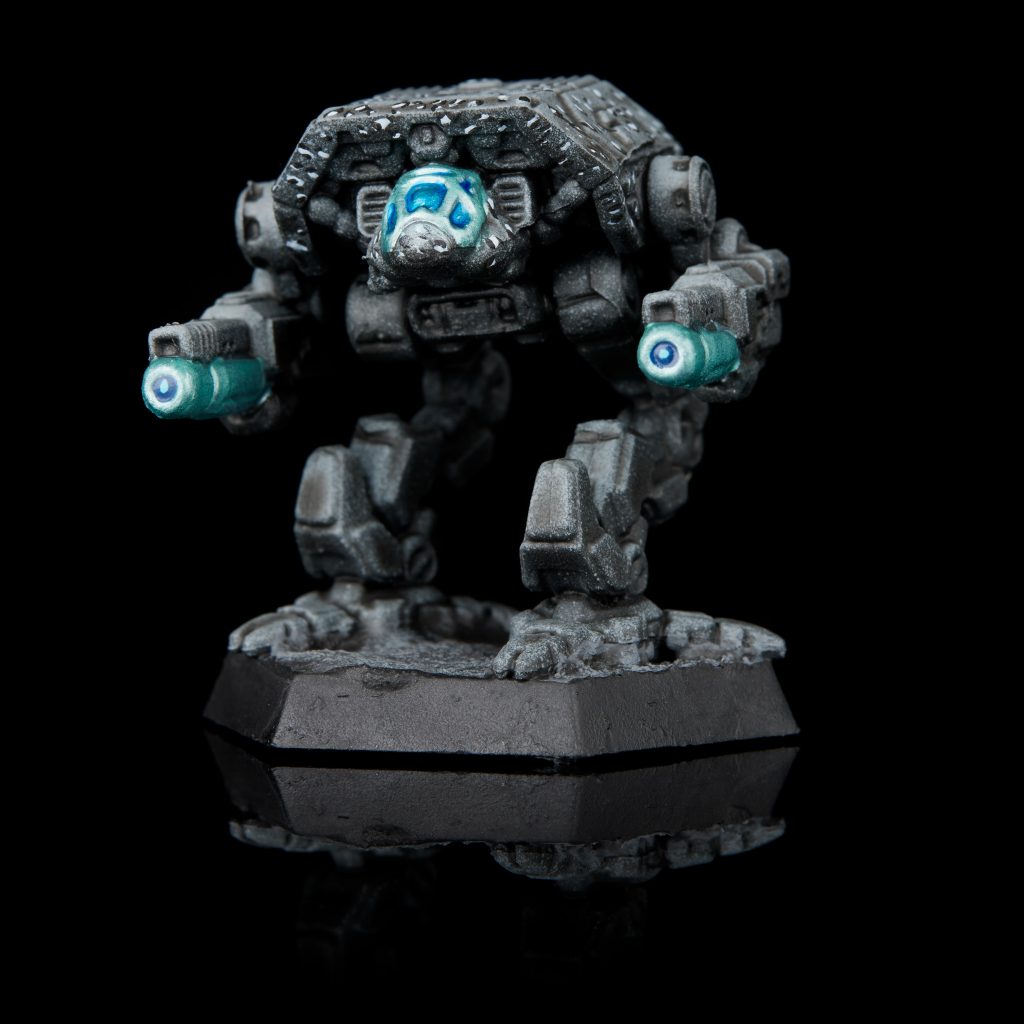
Puma (Adder) – The Puma has two Extended Range (ER) PPCs, a Targeting Computer, and a Flamer. This is a 35 ton mech armed with as much long ranged punch as a lot of medium or even (at 3025 level) heavy mechs, while still retaining the speed of a light mech. It pays for it in points, costing as much as some Inner Sphere assault mechs.

Grendel (Mongrel) – A 45 ton medium, you get three ER Medium Lasers, one ER Large Laser, one ER Small Laser, and a Streak SRM-6 (Streak SRMs are more accurate than their normal equivalents). Primarily a quick brawler, the large laser still leaves you with some good firepower at range.

Black Hawk (Nova) – Another medium mech, this time at 50 tons. The Black Hawk has 12(!) ER Medium Lasers (good luck firing them all at once with 18 double heatsinks). Tons of firepower as long as you can take some time to cool down.
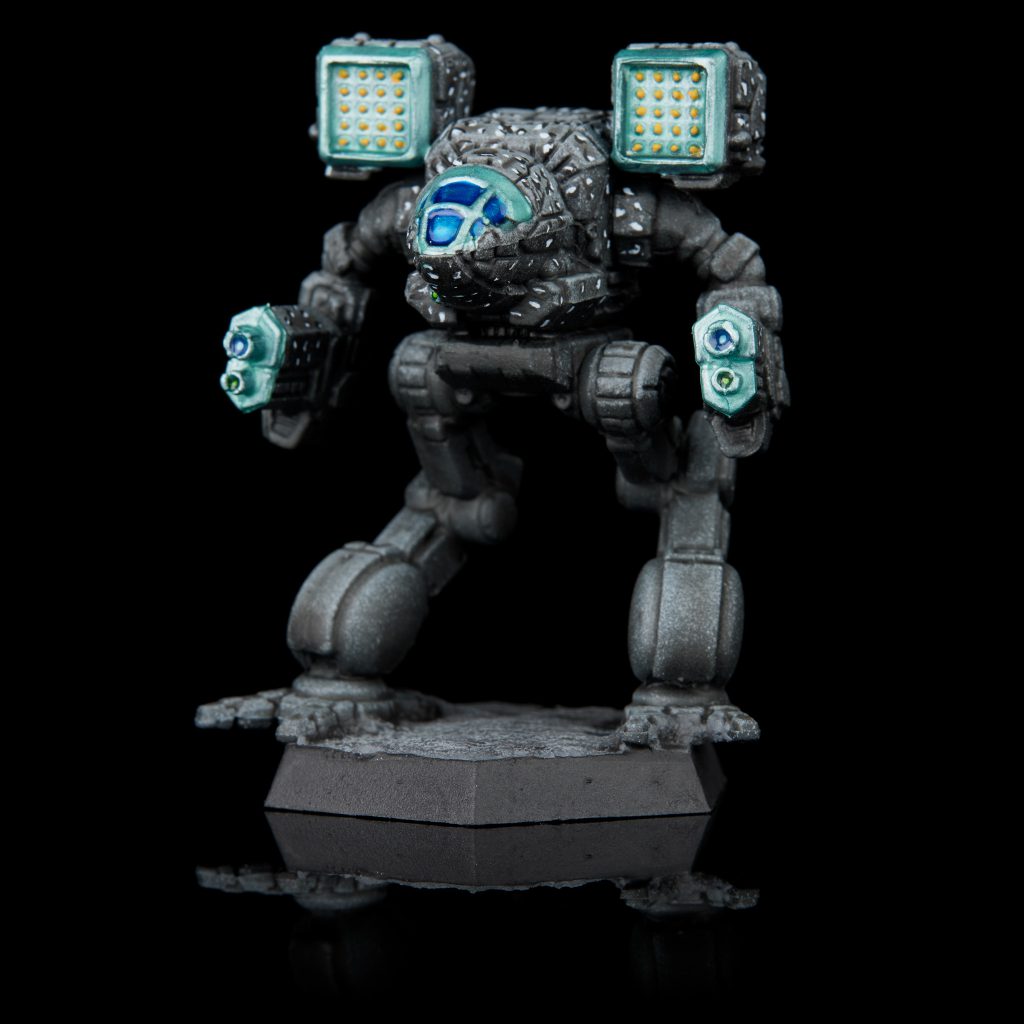
Mad Cat (Timber Wolf) – This is the poster child mech for the clans. The Mad Cat pairs two LRM-20s with two sets of ER Large and Medium Lasers. To complete the picture you’ve got a Medium Pulse Laser and two Machine Guns and 17 double heatsinks. This mech has a lot of long range firepower and armour, and is fast for a heavy mech as well.
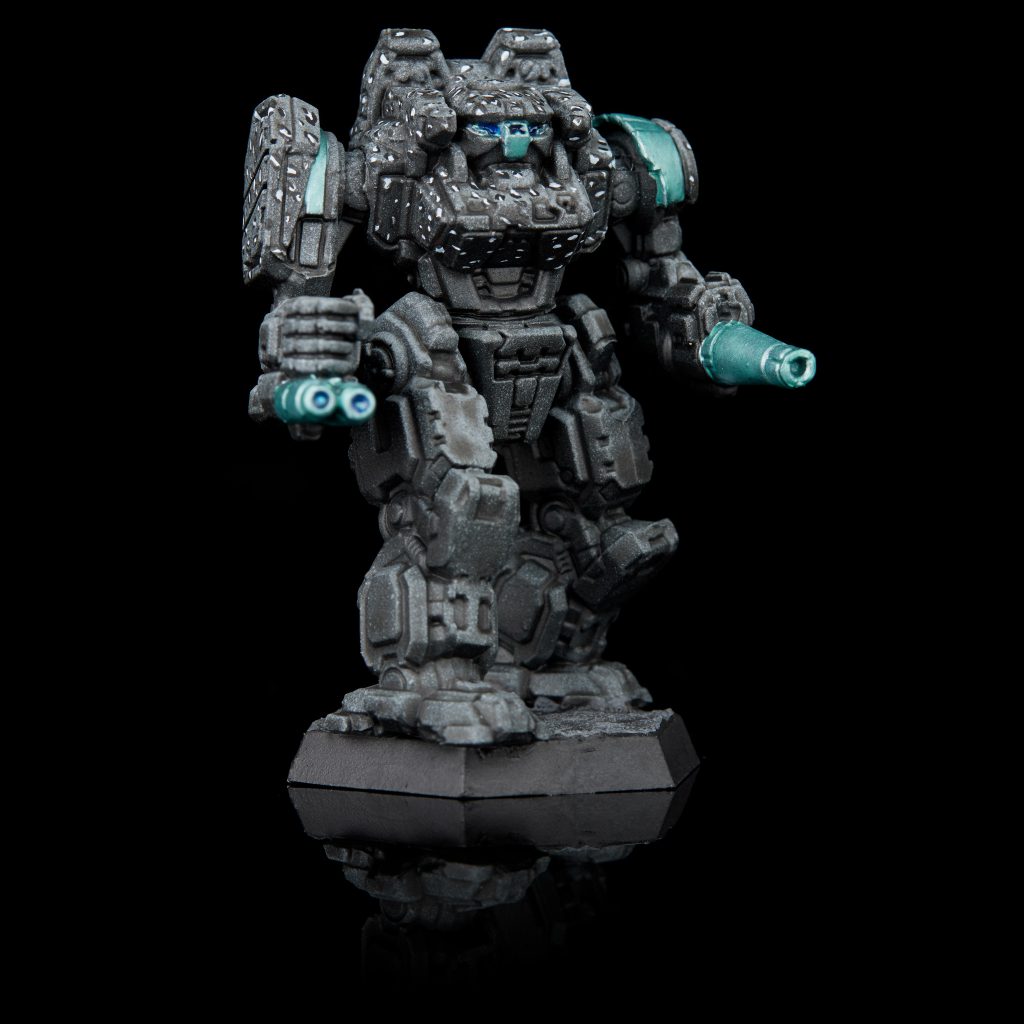
Gladiator (Executioner) – The assault mech, this baby clocks in at 95 tons. The Gladiator has a Gauss Rifle (think rail gun), two ER Large Lasers and two Machine Guns, but with 19 double heat sinks and a maximum heat from shooting of 24, it means handling heat is fairly easy. Heavily armored, the Gladiator is surprisingly mobile with a set of jump jets.
As a whole, the Clan mechs are higher technology than the Inner Sphere, with more range, firepower, mobility, and armor per mech, but get balanced out by not being able to field anywhere near as many.
The included mech record sheets include many of the mechs in the Force Packs Catalyst sells, but not all of them – probably an artifact of packaging changes during production. There are also included record sheets for one or two variants of each included mech.
Conclusion
Clan Invasion is nice to have, but of the three products I would get this last. You get a full Clan army (as Omnimechs are something you pay through the nose for), but you’ll inevitably want to branch out after a few games to add more Omnimechs or Clan versions of old Inner Sphere designs. If you are putting off committing to big rulebooks and like the level of game you are getting from the AGoAC box, then Clan Invasion is a solid buy to try the Clan era out, and to give you an Opfor for your Inner Sphere Mechs.
TLDR
Buy the Beginner box first and see if you even like the game, then A Game of Armoured Combat for a ‘full’ game experience using Succession Wars technology and keeping it to just mechs. If you want to add the Clan Era get Clan Invasion. If you’re enjoying it, and want to add more mechs, tanks, infantry and aircraft, then get Battletech: Total War and some record sheet packs for the era you want to play, and have fun. Battletech: Battle Mech Manual contains most of the same rules content as Total War, but only for mechs. For most people this is going to work better, at least until you get enough games under your belt to want to expand unit types.
If you’re sticking with just the plastic mechs available in Force Packs from CGL, and don’t need to have every single possible variant of those mechs, there are a set of downloadable record sheets available from this link to the downloads section of the Battletech website.
Battletech is confusing to get into (that’s half the point of writing this article) and it’s coming at you with a lot of supplements and things tagged as rulebooks which are in fact optional/advanced rules.
The starter boxes they have released are solid products, the minis are the best they’ve ever been in terms of detail (and there are now plenty of them and the new metals are showing a similar level of detail), and the Kickstarters have helped bring old players back in through publicity and funding range updates all at once.
The main mistake players make is trying to make their games too big too early. Lance vs lance is fine, 2 lances vs a clan star is a big game size, and beginning players fielding light lances against each other is absolutely fine. You aren’t missing out using mechs under 60 tons, playing on a map with a decent amount of terrain, and playing a game of ambush and maneuver. In fact you’ll learn a lot playing with mechs where you have to actively manage heat, hug cover, and play tactically. Mechs aren’t Warlord titans (as evidenced by the fact that Battletech and Adeptus Titanicus is roughly the same model scale) so you don’t have to play them that way.
My advice is to give 1 vs 1 mech games a go and if you enjoy it, evolve it from there. If you want to play big games (I guiltily look at the 5 inner sphere lances and 3 Clan stars I’ve got) then play Alpha Strike, which has a new boxed set coming out soon, and uses a streamlined and less detailed rule set.
Check back next time for us looking at next steps to expand from the box sets in either the Clan Invasion or Succession Wars.
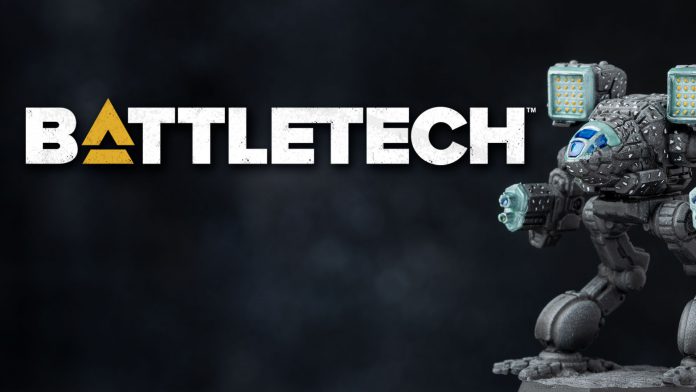


You must be logged in to post a comment.